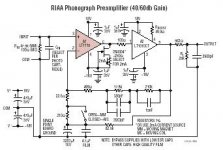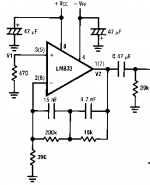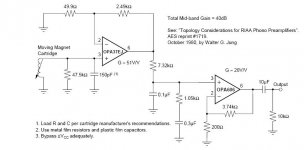I need to build an RIAA phono stage to feed a Velleman Valve preamp, which in turn will feed a JLH class-A amp.
Does anyone have any favourites? - at the moment I'm leaning toward the John Linsley-Hood shunt-feedback phone stage published back in '92, but maybe I should be using a newer, Opamp based design?
All advice gratefully received!
Peter Moreton
Does anyone have any favourites? - at the moment I'm leaning toward the John Linsley-Hood shunt-feedback phone stage published back in '92, but maybe I should be using a newer, Opamp based design?
All advice gratefully received!
Peter Moreton
My next project would be a Pass Aleph Ono.
http://www.passlabs.com/downloads.htm
A smaller version would be the Pearl Phono stage.
http://www.passdiy.com/preamps.htm
From what I read here, both are very nice sounding amps.
/Hugo
http://www.passlabs.com/downloads.htm
A smaller version would be the Pearl Phono stage.
http://www.passdiy.com/preamps.htm
From what I read here, both are very nice sounding amps.
/Hugo
Hi Peter,
I would consider using a single high quality OPAMP based design with full RIAA network CAREFULLY tailored around it. If you are after the best sound you would not want to be going through multiple OPAMP common mode etc.. limitations when all can be elegantly performed by just one. In fact the whole RIAA equalisation results in only +/- 6 dB NFB variation over the 20Hz - 20KHz audio band.
An LT 1028 is a good starting chip with 0.9nV/sqrt hz noise. LT's application notes will have ccts and Andy C's website derivations can help you finesse that. Take charge and learn.
Alternatively there are plenty out there who will happily sell you more complex hyped kits espousing the need for complexity to sell you more bits.
Cheers,
Greg.
I would consider using a single high quality OPAMP based design with full RIAA network CAREFULLY tailored around it. If you are after the best sound you would not want to be going through multiple OPAMP common mode etc.. limitations when all can be elegantly performed by just one. In fact the whole RIAA equalisation results in only +/- 6 dB NFB variation over the 20Hz - 20KHz audio band.
An LT 1028 is a good starting chip with 0.9nV/sqrt hz noise. LT's application notes will have ccts and Andy C's website derivations can help you finesse that. Take charge and learn.
Alternatively there are plenty out there who will happily sell you more complex hyped kits espousing the need for complexity to sell you more bits.
Cheers,
Greg.
Thanks for the responses, the Zen Perl design looks elegant, and would save me having to create a PCB layout, as this is downloadable.
However, a quick search of the linear.com website for "RIAA" reveals a complete phono stage using the LT1115 opamp, and this looks pretty neat also.
I have attached the Linear schematic, incase anyone would like to comment. 'm leaning toward the LT1115 solution, (and if I do this, I'll publish the PCB to this group.)
Peter Moreton
However, a quick search of the linear.com website for "RIAA" reveals a complete phono stage using the LT1115 opamp, and this looks pretty neat also.
I have attached the Linear schematic, incase anyone would like to comment. 'm leaning toward the LT1115 solution, (and if I do this, I'll publish the PCB to this group.)
Peter Moreton
Attachments
a fundamental question is your phono cart type; mc (hi/lo output) or mm (again some range of source Z and output within the generic type)
mm really don't like bipolar input bias current in the coil, and Zsource is so high that "low noise" bipolars give higher noise due to input noise current - AD743/5 still the best low freq noise monolithic fet op amps I know of and will beat the LT1115/1028 on noise with high Z in
I think the single feedback loop RIAA implementation has the fewest compromizes, but many single op amps can have marginal loop gain if you need a high preamp gain (mc) - if you are adventurous I would put 2 op amps with V gain inside the RIAA feedback loop (I would probably use a high speed current feedback dsl driver as the output op amp - and remember; composite amp frequency compensation is fun)
mm really don't like bipolar input bias current in the coil, and Zsource is so high that "low noise" bipolars give higher noise due to input noise current - AD743/5 still the best low freq noise monolithic fet op amps I know of and will beat the LT1115/1028 on noise with high Z in
I think the single feedback loop RIAA implementation has the fewest compromizes, but many single op amps can have marginal loop gain if you need a high preamp gain (mc) - if you are adventurous I would put 2 op amps with V gain inside the RIAA feedback loop (I would probably use a high speed current feedback dsl driver as the output op amp - and remember; composite amp frequency compensation is fun)
I built this http://www.geocities.com/rjm003.geo/rjmaudio/diy_pho5.html
and was positively suprised by how well it performs in my setup.
I have been procrastinating on this amp for the past 2 years...
http://home.pacifier.com/~gpimm/phono.htm
and was positively suprised by how well it performs in my setup.
I have been procrastinating on this amp for the past 2 years...
http://home.pacifier.com/~gpimm/phono.htm
the Linear schematic
I have built something similar topology-wise with AD8610 followed by a BUF634. It is very optimistic to expect compatibility with low output MCs so i use transformers. Don't see any point in such a big output resistor and certainly don't have electrolytic caps in the feedback loop. Output offset <2mV.
Is it great? No. Even with discrete regulators and resynthesised 50Hz supply. Caddock resistors and polystyrene riaa caps. And lots of BGs in the PS. I believe a passive split RIAA ala Hagerman has more sonic potential. At the expense of 4 more regulators and AC coupling.
There is one near back of the following datasheet:
http://cache.national.com/ds/LM/LM833.pdf
It has the virtue of simplicity, i.e., you use a single opamp per channel or even use a dual for both. This is almost a generic design, both Slone and JLH show versions of it (just different RC combinations) in their books. I've seen it in other places as well. It's probably too prosaic to have audiophile status, but when I listened to one it seemed to do the job as well as the upscale designs. However, I'm one who never regreted the demise of the LP - so I'm probably not qualified to opine.
Nonetheless, since it can be constructed on a breadboard in a few minutes it can be used as a minimum performance baseline. Namely, any alternative design that does not sound at least a little better probably isn't worth pursuing. The judgement as to what sounds better I'll leave up to those more into to vinyl than I am.
http://cache.national.com/ds/LM/LM833.pdf
It has the virtue of simplicity, i.e., you use a single opamp per channel or even use a dual for both. This is almost a generic design, both Slone and JLH show versions of it (just different RC combinations) in their books. I've seen it in other places as well. It's probably too prosaic to have audiophile status, but when I listened to one it seemed to do the job as well as the upscale designs. However, I'm one who never regreted the demise of the LP - so I'm probably not qualified to opine.
Nonetheless, since it can be constructed on a breadboard in a few minutes it can be used as a minimum performance baseline. Namely, any alternative design that does not sound at least a little better probably isn't worth pursuing. The judgement as to what sounds better I'll leave up to those more into to vinyl than I am.
This PDF is an app note with more RIAA preamp info and ideas.
http://www.national.com/an/AN/AN-346.pdf
http://www.national.com/an/AN/AN-346.pdf
Hey Mike!..
Yep..Gary Pimm has those as parafeed caps for his output tranformers. (The page I linked to was Gary Pimm's)
Mine is still in this phase..
http://basenjes.de/tubes/gphono.htm
well slightly further....
Mine will be without tranformers for starters by the way..
Regards,
Bas
Yep..Gary Pimm has those as parafeed caps for his output tranformers. (The page I linked to was Gary Pimm's)
Mine is still in this phase..
http://basenjes.de/tubes/gphono.htm
well slightly further....
Mine will be without tranformers for starters by the way..
Regards,
Bas
Hi Peter,
Simple's always a good place to start. The LM833 cct below as lifted from the link provided is close. only with the newer single op amps like LT1028, etc...
A couple of improvements though , if you're doing a board. A series R should be added between the RIAA network and the output feedback point. This can serve two finctions - low Z loading limiter (as the RIAA > 0 at hf) ans cutting lathe 50KHz zero provision.
When selecting the actual component values (recomment Andy C's website) or scaling the values shown, consider increasing the LF time constant considerably by increasing the 200K -> 300K for a fuller low bass consistent with a lack of 20Hz break in ther recording eq.
jcx,
The LT1028 has input stage bias cancellation so DC bias currents through the cartridge are likely acadaemic? Also the high Z source impedance source impedance you speak of , that would more suit a FET op amp, is dubious as the typical MM cartridge is usually characterised as , IK in series with 600mH and most audible nois according to Fletcher Munson is in the 500-3KHz range where source impedance is typ 2K-7Kohm. Also the RIAA eq at hf tends to further supress hf contribution. I vaguely recall NS doing an octave by octave analysis.
But I have to agree with your -
"..... if you are adventurous I would put 2 op amps with V gain inside the RIAA feedback loop (I would probably use a high speed current feedback dsl driver as the output op amp - and remember; composite amp frequency compensation is fun)"
I would suggest a discrete FET diff'l pair followed by a high speed high drive op amp in one loop (all as the op amp pictured) with tailoring of the diff'l pair back to unity at hf for stability. Simple and effective AND fun!
Cheers,
Greg
Simple's always a good place to start. The LM833 cct below as lifted from the link provided is close. only with the newer single op amps like LT1028, etc...
A couple of improvements though , if you're doing a board. A series R should be added between the RIAA network and the output feedback point. This can serve two finctions - low Z loading limiter (as the RIAA > 0 at hf) ans cutting lathe 50KHz zero provision.
When selecting the actual component values (recomment Andy C's website) or scaling the values shown, consider increasing the LF time constant considerably by increasing the 200K -> 300K for a fuller low bass consistent with a lack of 20Hz break in ther recording eq.
jcx,
The LT1028 has input stage bias cancellation so DC bias currents through the cartridge are likely acadaemic? Also the high Z source impedance source impedance you speak of , that would more suit a FET op amp, is dubious as the typical MM cartridge is usually characterised as , IK in series with 600mH and most audible nois according to Fletcher Munson is in the 500-3KHz range where source impedance is typ 2K-7Kohm. Also the RIAA eq at hf tends to further supress hf contribution. I vaguely recall NS doing an octave by octave analysis.
But I have to agree with your -
"..... if you are adventurous I would put 2 op amps with V gain inside the RIAA feedback loop (I would probably use a high speed current feedback dsl driver as the output op amp - and remember; composite amp frequency compensation is fun)"
I would suggest a discrete FET diff'l pair followed by a high speed high drive op amp in one loop (all as the op amp pictured) with tailoring of the diff'l pair back to unity at hf for stability. Simple and effective AND fun!
Cheers,
Greg
Attachments
check out the lt1028 i_noise spec, 1 pA/sqrt(hz) * 2-7 KOhms is 2-7 nV/sqrt(hz) right in your peak sensitivity region, the ad743 2.5-3 nV/sqrt(hz) V_noise is a bargan, clearly beating the lt1028 with mm cart
low freq 1/f noise could be a problem with other fet input op amps with the riaa Lf boost largely canceling the A weighting noise Lf roll off - the ad743 keeps the 1/f Vnoise corner lower than any other fet input op amp I know of
low freq 1/f noise could be a problem with other fet input op amps with the riaa Lf boost largely canceling the A weighting noise Lf roll off - the ad743 keeps the 1/f Vnoise corner lower than any other fet input op amp I know of
Just came across a schematic using two opamps sandwiching a passive filter (attached below). Walter Jung describes the technique in his paper "Topology Considerations for RIAA Phono Preamplifiers" which you can download from his website.
At the moment, this passive filter design is favorite, any comments from the experts? [ before I waste more time... ]
]
At the moment, this passive filter design is favorite, any comments from the experts? [ before I waste more time...
Attachments
I don't have any favored theory whether active or passsive will sound better. andy_c's paper is impressive and there is a certain elegance into wrapping the whole thing neatly around a asingle opamp. However, being that I'm grey-mattert-limited, I find the passive approach easier to comprehend as it lets me think about just one thing at a time.

Peter:
I've been happy using an Analog Devices AD743 driving National Semiconductor LM6321 unity gain buffer (NLA from National ). I could recommend this approach similar to the Linear Technologies data sheet for the LT1115 posted earlier. Strongly recommend to spend some time at Andy_C's site to pick the right network values, though. Great resource Andy_C!!!
). I could recommend this approach similar to the Linear Technologies data sheet for the LT1115 posted earlier. Strongly recommend to spend some time at Andy_C's site to pick the right network values, though. Great resource Andy_C!!!
Greg's suggestion about using some JFETs followed by a high drive op amp sounds intriguing, too. Oddly enough, I've got a bunch of the old Toshiba low noise high gain JFETs paired in a can (2SK146?) that I should stick in front of an AD811 or something to see what happens. I've seen this approach in a number of Japanese receivers and integrated amps from the 1980's and early 1990's but usually with nice JFETS feeding some crappy op amp.
Thanks for the flashback/reminder, Greg ...
mlloyd1
I've been happy using an Analog Devices AD743 driving National Semiconductor LM6321 unity gain buffer (NLA from National
 ). I could recommend this approach similar to the Linear Technologies data sheet for the LT1115 posted earlier. Strongly recommend to spend some time at Andy_C's site to pick the right network values, though. Great resource Andy_C!!!
). I could recommend this approach similar to the Linear Technologies data sheet for the LT1115 posted earlier. Strongly recommend to spend some time at Andy_C's site to pick the right network values, though. Great resource Andy_C!!!Greg's suggestion about using some JFETs followed by a high drive op amp sounds intriguing, too. Oddly enough, I've got a bunch of the old Toshiba low noise high gain JFETs paired in a can (2SK146?) that I should stick in front of an AD811 or something to see what happens. I've seen this approach in a number of Japanese receivers and integrated amps from the 1980's and early 1990's but usually with nice JFETS feeding some crappy op amp.
Thanks for the flashback/reminder, Greg ...
mlloyd1
Attached is the Phono schematic that I'm settled upon (drawn in my PCB package) The design is an implementation of something I found in the TI/Burr-Brown OPA606 datasheet, and this itself draws upon ideas by Walter G. Jung (see : http://home.comcast.net/~walt-jung/wsb/html/view.cgi-showresources.html-TopRes-Walt-27s-20PDFs.html)
Comments on the schematic most welcome (I'm a digital guy, so go easy on me!)
I'll post the PCB overlay later. (If it's worthwhile!)
Comments on the schematic most welcome (I'm a digital guy, so go easy on me!)
I'll post the PCB overlay later. (If it's worthwhile!)
Attachments
- Status
- This old topic is closed. If you want to reopen this topic, contact a moderator using the "Report Post" button.
- Home
- Amplifiers
- Solid State
- Good Phono preamp circuit?


